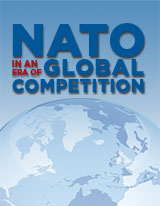Leading experts on NATO’s traditional tools of reassurance, dissuasion, and deterrence gathered at NATO in an Era of Global Competition to address the implications of Russia’s continuing destabilization of Ukraine for European security and to assess the West’s response to this crisis.
Moderator James Goldgeier, dean of American University’s School of International Service, asked the panelists what Ukraine can do to bolster its deterrence and collective defense capacities in the wake of the Ukraine crisis since it is not a NATO member. Etienne de Durand of the Institut Français des Relations Internationales, Jo Gade of the Norwegian Institute for Defence Studies, and Kori Schake of the Hoover Institution at Stanford University brought a diverse synthesis of Western and European perspectives to the discussion. The panelists first outlined their thoughts on the future of Russia-NATO relations, the future of Article 5 threats, and President Obama’s European Reassurance Initiative.
Schake responded first by saying, “I actually don’t think Russia poses much of a physical threat,” demonstrated anecdotally by the Norwegian air force and Polish army capabilities. Schake perceived the Russian threat to NATO as psychosomatic, saying, “We are talking ourselves into the belief that we are weak, when we are not.” Another concern that Schake outlined was “the shadow of causing NATO governments to make choices about Russian populations” in their own territories. On the European Reassurance Initiative, she characterized Obama’s contribution as a “reflexive overreaction,” stating that “he thought Europe would match us, but that is not probable”.
De Durand replied to the question of Russian aggression by recognizing their physical capacity and history. While he acknowledged that this crisis does not mean “a Cold War”, he also asserted, “we must recognize that Russia is a huge force and that sanctions won’t do it.” In response to what can be done to strengthen reassurance and collective defense, he suggested that NATO focus on intelligence capabilities and improving our speed of response in Eastern Europe. He stressed that reassurance exercises are transparent in countries like Estonia and admits that “rotations and exercises are not going to do the trick”. De Durand said, “We need to start a new conversation about nuclear defense in ways that we haven’t in the past.” In the context of European contribution to collective defense, de Durand was firm in establishing his point of improved European cooperation. His suggested solution was to make “sure that incentives are created for France and Britain to show up.” Due to financial bounds that limit money from European militaries, he claimed, “The battle we are fighting now is with the treasury.”
Gade emphasized the importance US leadership and European contribution for a strong NATO future. His perspective was that existing plans are “too dependent on the NATO response force”. He put simply that, “We must increase reassurance” in addition to considering how NATO can best respond to “hybrid warfare.” NATO must consider whether or not their command structure is properly suited for future missions. He stressed the importance of a “robust NATO force structure with the right capabilities”. One high value exercise every three years Gade argued, is “not enough.” To strengthen reassurance and collective defense, he suggested that we “need to ensure that the maritime forces have the required capacity and that they can respond quickly when needed.” Gade agreed with Schake and de Durand that the level of financial responsibility within NATO must be taken more seriously.
